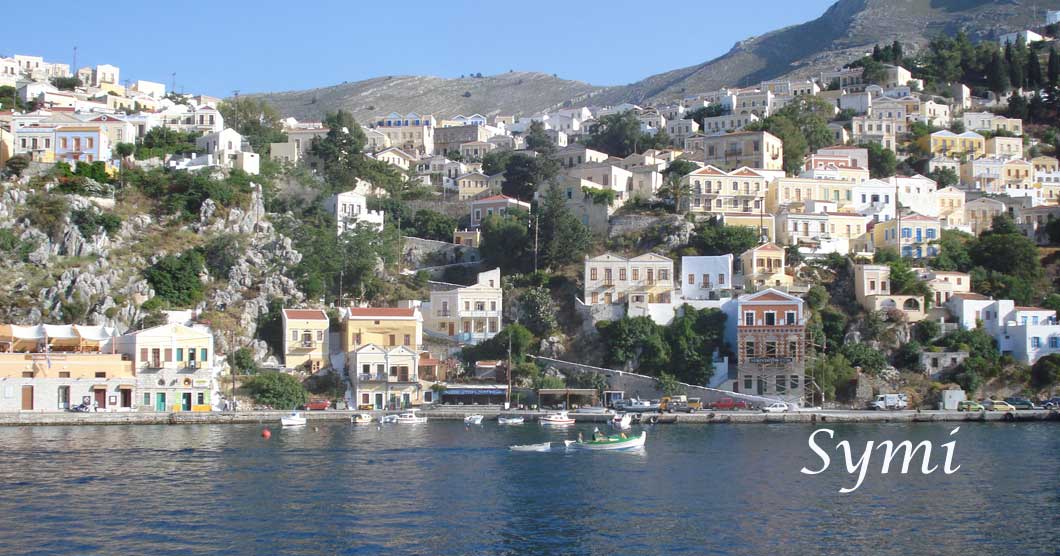Symi island Greece
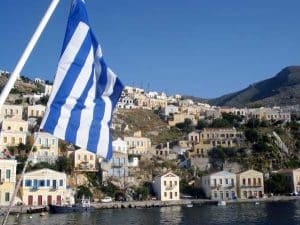
Once famed for its wooden shipbuilding and for its sponges, Symi now relies almost entirely on tourism. Trees have disappeared from much of the island and sponges have vanished from its waters.
Symi is a small island with a population concentrated in the port resort of Gialos where dozens of ferries tie up daily. Paved roads lead to a few beaches and the rest of the island is laced with rough track and mule paths.
Taxi boats provide services to the more remote beaches, otherwise they can only reached by a trek over the hills.
There’s not a great deal of holiday accommodation on this small island and what there is, is concentrated around the main island port.
There is only one major resort at Symi Town or Gialos with a population of 2,500. Another 500 live in hamlets scattered around the coast. Symi has one fertile plain behind Pedi, the rest is mostly rock with pockets of pine and oak. The highest point is Mount Vigla at 616m.
Shipbuilding and sponges were the main industries in the 19th century when the population reached 22,500. The main industry today is tourism.
About Symi
Symi it’s a small, unspoilt island which attracts hikers, nature lovers and those thirsting for a taste of the “real Greece”. Hundreds of day trippers flock here in the summer months from nearby Rhodes which is a far bigger and more popular holiday destination. They come to visit one of the most attractive harbours in Greece and the island’s famous Monastery of the Archangel Michael. The islanders and those foreign visitors who have come to soak up Symi’s slow pace of life breathe a sigh of relief when the ferries ship away the masses before sun down.
The island has no airport but there are regular ferry services to and from Rhodes (two hours) which has an international airport with flights to Athens, several UK airports and other European capitals. A Flying Dolphin will get you to Rhodes, 11 kilometres south of Symi, in just under an hour. There are also regular ferry and hydrofoil services linking the island with several others in the archipelago.
The island is just 13 kilometres from north to south and eight kilometres from west to east with a total area of 68 square kilometres. It’s best explored on foot or by water taxi as the road “network” is a one carriageway affair doesn’t give access to the island’s far flung corners.
Ferries dock at the main port town of Gialos which is a delightful concoction of strikingly beautiful pastel coloured neo-classical mansions arranged in tiers on the steep hillside overlooking the harbour. The town is mercifully free of modern development and remains architecturally protected by law from the ravages of mass tourism which have scarred many of the bigger resorts in the Greek islands. The port’s grandiose buildings serve as reminders of a more glorious bygone age when Symi prospered from its lucrative ship building and sponge diving trades. Less than a century ago this was one of the wealthiest of all the Greek islands.
But the ship building industry went into decline and the advent of synthetic sponges sounded the death knell for the decidedly hazardous occupation of diving for the real thing.
Now Symi is very much the poor relation of affluent Rhodes, too short of fresh water to support anything other than a relatively small tourist industry. You won’t find huge luxurious hotel and conference complexes here nor the kind of frantic nightlife for which the Rhodian resort of Faliraki is so famous.
What you will find is an attractive island peppered with dozens of tiny monasteries, forested with pines, oaks and junipers and fringed by numerous pretty pebble coves many of which can only be reached on foot or by water taxi.
Architecture
Symi preserved the neoclassical character of its architecture, which is why it was declared a historic protected settlement. Thus it is a uniqueness in the Aegean. Its houses, two-story and even three-story, with well-kept courtyards.
Often paved with cobblestone floors, forming ships, anchors,decorative themes with gardens planted with citrus trees,gardenias, arbors, with magnificent gables decorated with elegance between their gabled tiled roofs, balconies with simple ironwork – sometimes stone or brick stands out on the outer walls – with ocher color as the most characteristic element and brown windows, not missing purple or green doors with wonderful knockers, tabards and ironwork.
Inside usually painted ceilings, wood-carved musandres, elegant furniture, commodes, mirrors, small tables and consoles, china and crockery piled in cupboards.
With hand-embroidered kandras to represent the Acropolis, flowers, scenes from Erotokritos. Equally rich are the embroideries on the furniture, the curtains, the old sailors’ trunks.
The village today sees its houses being restored one after another, those that had been destroyed by war or abandonment and life reblooming in the alleys, streets and squares.
In the preservation of the traditional settlement of Symi, the presence of the Archaeological Service, the architects and civil engineers of the region as well as our local craftsmen is important. Specialties such as bricklayers, blacksmiths, lantern makers, carpenters and others have great works of art to show.
History
A rich mythical tradition reflects the history of island, which was first inhabited during prehistoric times. King Nireus who participated in the Trojan War became a legend, a legend which was preserved right down to Byzantine times.Symi followed the same fate as the other Dodecanese.
Its residents were highly successful sponge divers and shipbuilders and thus managed to obtain significant privileges when the island was conquered by the Turks in 1522. At that time important cultural organizations were established such as the Aghia Marina School and the Aigli Reading Room. The Protocol handing over the Dodecanese to the Allies was signed on Symi on 8th May 1945. The island was finally integrated into Greece in 1948.
Gialos the capital of Symi
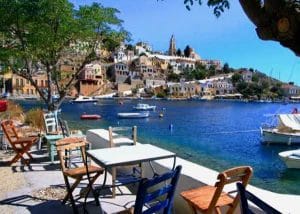
Neoclassical houses with two- or three-story tiled roofs, with special metopes, tightly packed, with strong warm earthy colors, rise from the Village and reach the outskirts of the Castle and among them stand out the bell towers of over ten churches.
Immediately after is the beautiful building of the customs office and behind the stone bridge that joins the two sides of Gialos. Behind the square with the town hall building and the maritime museum is the Cathedral of the Holy Forerunner, built in 1838, with its mosaic courtyard and the magnificent illuminated bell tower.
Villages
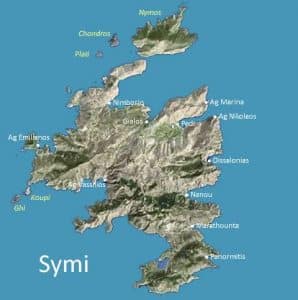
Symi has 6 main villages. Gialos, which includes the port, is the most central and touristic place you can stay. It is also an ideal spot when you don’t have a means of transport, since there are most of the island’s accommodations, cafes, restaurants and the boats that will take you to the island’s beaches.
Chorio or Ano Symi is the traditional settlement of the island where many of the permanent residents live. It is located on a hill in relation to Gialos and is connected to the port by 500 steps called Kali Strata. These stairs are the main reason why is not recommended to stay in Chorio since you will need to go up and down them several times to get to the port.
If you have a means of transport, another tourist settlement worth staying in is Pedi. There are beautiful accommodations on the homonymous beach, cafes and restaurants. Pedi is connected to Gialos by a good road network, but you can also walk 20-30 minutes from one settlement to another. In general, walking is very popular in Symi.
When the danger of pirates was eliminated, the village extended down to the sea and thus the second important settlement, Gialos, was created. The captains and merchants of Symi built their mansions here.
The two settlements are joined by Kali Strata, a road with 500 wide steps. In the past this was the commercial street of Symi and walking along it you will have the opportunity to see magnificent mansions built on both sides of it.
The entire Chora, Gialos and Ano Symi, has been designated as a preserved settlement and of course a single walk is not enough.
What to see in Symi
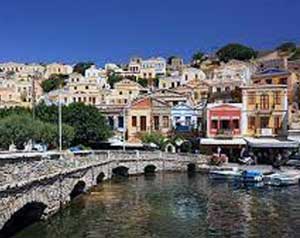
The Gialos Monument is particularly impressive as it is a copy of the Trier of Lindos and is carved on the rocks.
You will see it while walking on the beach of Symi. It was created in commemoration of the Protocol of the surrender of the Dodecanese to the Allies in 1945.
Every year on May 8 a student and military parade takes place with the laying of wreaths in commemoration of that day.
The National and Ionian Bank buildings, the Town Hall, the Maritime Museum, the Police Building, the Petrideio Primary School.
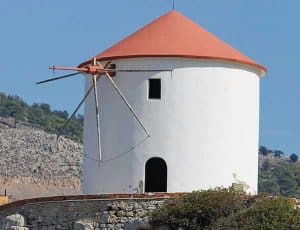
Byzantine ruins, a damaged mosaic, twelve underground vaults known by the locals as the ‘Twelve Caves’ which during Byzantine times must have been used as a painting and sculpture workshop. The remains of a Paleo-Christian basilica below the church of Aghia Irini.
The stone grape presses, the most interesting of which are in the area known as Kourkounioti.
Fortresses of Symi
The Knights Castle, with their emblem over the entrance, located at the highest point of the upper town. Built on the ruins of ancient and Byzantine remains with parts of the walls which once surrounded the acropolis on the hill. At the highest point lies the small chapel of the Virgin Our Lady (Kyra Panaghia) with a panoramic view of Horio and Yialos.
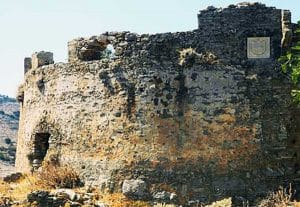
Monasteries and Churches
Roukouniotis Monastery, 15th century, built like a fortress. Outside the monastery walls one can see a centuries old cypress tree in the shape of an umbrella.
Great Saviour monastery: on the road for Panormitis set in wonderful surroundings. This is a metochi (dependency) of Panormitis Monastery. Built like a fortress it has cells lining the side of the Katholikon dedicated to the Transfiguration of Christ the Saviour (Metamorfosi Sotira).
Archangel Michael Panormitis monastery
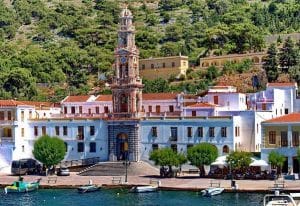
In the museum in addition to ecclesiastical vessels, small painted icons and gold and silver objects there are also dedicatory offerings placed in bottles by sailors since it is said that they ‘save’ them from the sea. The monastery’s library contains many books and handwritten codices from the 16th, 17th and 18th centuries.
During World War II the monks were active in supporting Greek and Allied soldiers. Residents of Symi call Archangel Michael Panormitis a ‘thief’, somewhat tongue in cheek, because if a dedicatory offering is not made the Archangel finds some way to take it himself.
In the area of Emborios or Nimborio there is the chapel of Christ Ascended (Analipsi Christou) in Kokkinochroma Bay next to the sea as well as the church of Panaghia Apokoui on the islet of Nimos.
Archaeological and Folklore Museum in Horio.
This include an archaeological collection of Hellenistic and Roman sculptures, heads of statutes, grave slabs, terracotta death masks from the 5th century BC, inscription, vessels and coins and a Byzantine collection of icons and heraldic marks from the 15th century, crosses, Byzantine music manuscripts, Paleo-Christian capitals, 13th century roll books and coinage as well as a folklore collection with wooden carvings, clothing, textiles, everyday tools, musical instruments, a sewing machine, weapons, sailing equipment and a figurehead.
The Hatziagapitos Mansion near the Archaeological Museum. Here one can view the rooms of this mansion which was once home to a leading merchant.
Cultural events
Folklore feasts and Celebrations
The Feasts of Aghia Triada (the Holy Trinity), Aghios Ioannis on 24th June, Aghios Panteleimon on 27th July and the Virgin on 23rd August in Nimos. Carnival is celebrated with masquerades and partying in the streets.
The Feast of the Panaghia Myrtariotissa is held of 14th August.
In the area known as Alithini (between Pedi and Yialos) the feast of the Virgin takes place on 15th August.
At Panormitis two major feasts are celebrated which attract large crowds from all over the Dodecanese, on 8th November the two day long feast of Pentecost and on 6th August the feast of the Saviour. Fried cod with potato salad, wine, grapes and figs are served up.
Customs and lore
On 2nd May Ano Symi is aroused by the custom known as “Koukouma”. From the eve, girls call at seven houses where women named Irene live, take water without speaking, and make an unleavened pie. The following day at the gathering of all residents the pie is cut and offered up to the unwed so they may dream of their future husband providing them with water. This is followed by a party.
Things to do in Symi
The annual Symi Festival held from July to September, is an important cultural event with theatre, cinema, dance, music and art exhibitions.
During winter and summer both locals and foreigners go on pleasant trips to the tens of chapels to be found scattered across the beautiful landscape allowing one to forget one’s woes, to relax and enjoy the church’s feast day. Some offer “akoumia”, a traditional speciality, coffee or sweets while others offer food and drink.
At the bars along the coastline and in Horio young people unwind with top quality music and at the outdoor club “Alithini” each Saturday during the summer months there is live music and dance.
The three-month long Symi Festival lasting from July to September which excels in terms of organization and quality events allows thousands of locals and foreign tourist to attend events, thus combing a pleasant stay with top level culture. The Festival includes traditional, modern and classical music concerts, theatre, cinema, art exhibitions, and poetry and literature evenings.
Book fairs, evenings of dance with island music and sports events are also organized throughout the summer. Cultural events are organized all year round by the municipality’s cultural centre.
When to go to Symi
Summers in Symi are notoriously hot with average temperatures in July and August of 33°C and often rising to 40°C and above in the main port of Gialos which is set in a steep sided amphitheatre of hills that create a sweltering micro climate.
Spring and autumn are considered the best times to visit Symi, especially early in the year when wild flowers are abundant and especially for walkers when fresh breezes keep the temperatures down. Winters in Symi are mild but wet.
Where to stay in Symi
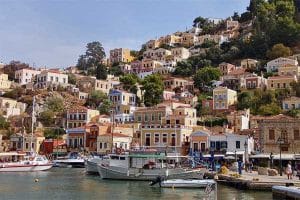
In contrast to many other Greek islands, accommodation can be easier to find in July and August as the searing temperatures tends to put off many people. Accommodation is harder to find in the spring and autumn – the most popular seasons for Symi holidays.
Room owners will sometimes meet incoming ferries but they are not as plentiful as on other Greek islands. The Symi Visitor has offices on the north side of the harbour and they may find you a room somewhere.
There are many self-catering studios in Gialos and in the Chorio above. Alternative holiday accommodation can be found in the fishing village of Pedi, east of Chorio, which has seen a recent growth in small hotels and studios. To the west of Gialos is Nimborios and a large complex of self-catering apartments.
There are no authorised camping sites on Symi and illegal camping is heavily frowned on. For a cheap night with peace and quiet try checking into a pilgrim’s room at the Taxiarchis Michail Panormitis monastery which offers a bed for the night for a small donation.
Getting around Symi
Car hire is hardly needed on Symi as the island has at least five water taxis that head out daily to the main beaches.
Renting a car or moped can be useful if you have luggage to carry but with only a few paved roads there is not really anywhere to drive to except Pedi, Nimborio and Panormitis.
Car and moped hire is available in Gialos harbour and in Pedi Bay. Off road tracks are usually poor and sometimes dangerous. There are a couple of petrol stations on the road to Pedi.
Half a dozen taxis operate out of Gialos. The longest trip is to the monastery at Panormitis – agree the price before getting in. A good time to get a taxi is when the ferry boats are due to arrive as that is when the drivers gather in the harbour.
Water taxis run frequently out of the harbour at Gialos to Agia Marina, Agia Nikolaos, Nanou and Marathounda and also in the opposite direction to Nimborio. There are also several ’round island’ day trips that start from the harbour. Small boats can be hired in the harbour as well.
Symi Bus (green) runs a reliable hourly shuttle service between Gialos, Chorio and Pedi up to 11pm. A minibus runs twice a day to Panormitis. It takes 30 minutes with stops on the way to take photos.
Symi is also just 13 kilometres north – south and nine kilometres east-west so it’s walkable, although walkers should take plenty of water as there are no facilities.
Most walkers head inland to explore the pine-clad interior and the many monasteries and chapels which pepper the island. Symi has some good walking trails but many paths are little more than goat tracks and are in a ruinous state.
Wooded walks can be found in the centre and north of the island although the most populous area around Gialos is rocky and barren.
Beaches
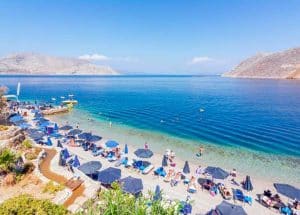
Also in Nos there are the usual pebbles but there are also sunbeds and umbrellas in addition to the usual tavern. The strong point of this beach is the panorama that extends all around the coast.
Pedi, a large bay where one of the Symi settlements is located. This stretch of coast offers a series of consecutive beaches that are also very popular with snorkelers.
There are also some taverns nearby that are worth a visit: they specialize in fish and offer simple but exquisite dishes. Some boats also leave from here to reach the other more isolated beaches of the island.
The most beautiful beach is Agios Georgios Dysalonas, which darkens in the afternoon due to its impressive vertical rocks.
At Panormitis there is a stretch of gravel beach with splendid water but above all with a wonderful environment around it. It is located on the south side of the island and is close to the Panormitis Monastery.
How to get to Symi

There are scheduled flights to Athens and Symi visitors can catch a ferry from the port at Piraeus but it’s a very long journey time.
Flights to Rhodes can sometimes connect with ferry services but most opt for an overnight stop in Rhodes and a ferry from Mandaraki harbour the next day.
Rhodes airport is 16 kilometres from the town harbour and there are plenty of buses. Although there is no dedicated airport hotel, accommodation is plentiful along the route from airport to harbour.
Kos island has a shorter flight time from the UK but the ferry trip is longer. Regular ferry connections include catamaran services by Dodekanese Seaways between Kos and Rhodes via Symi.
Most charter flights from the UK fly Wednesdays and Saturdays. On Saturdays the flights tend to arrive in Rhodes in the early hours of Sunday which can be useful for the 9am Symi ferry.
Getting to Symi by Ferry
Two major ferry companies currently run routes to Symi while several small firms run day trips and excursion to the island from Rhodes and from Turkey.
The catamarans Dodekanisos Pride and Dodekanisos Express operated by Dodekanisos Seaways leave from Rhodes’ Colona harbour daily calling in at Symi, with a journey time of about 45 minutes.
A service by Blue Star Ferries also calls in a Symi on its run from Piraeus to Kaztellortzo calling in at Astypalaia, Patmos, Lipsi, Leros, Kalymnos, Kos, Nisyros, Tilos and Rhodes. It runs weekly from Piraeus on Wednesdays and twice weekly from Kalymnos on Fridays and Sundays.
There are any number of day trip boats offering excursions from Rhodes to Symi. Most operate from Mandraki harbour on Rhodes from April to October, leaving Rhodes at around 9am with some calling at the monastery of Panormitis on the way.
Aegean Tour Travel runs Sunday only hydrofoils from Bodrum, Turkey, from May to October while E-Ferry has fast catamaran services between Symi and both Bodrum and Dacta and Yesil Marmaris Lines runs a Rhodes to Bodrum service in the summer that calls in at Symi.
Water taxis run out of Gialos daily to the various island beaches. There are plenty of round-island day trips starting from the harbour. The boats display details and prices in the harbour next to the water-taxis. Small boats are also available to hire.
Tour boats generally leave Gialos at 10.30 am and return before 6pm. Some trips include a barbecue lunch and may be combined with a walk or bus trip through the interior.
There are also excursion tours to beaches on neighbouring islets such as Sesklia with a barbecue lunch and drinks usually included. Visiting boats can moor in Gialos, Nimborio, Pedi, Panormitis and Agios Emilianos.
Useful Telephones
Municipal Services : +30.22410.71302
Police : +30.22410.71111
Port Master’s Office : +30.22410. 71205
Rural Surgery : +30.22410.71316
